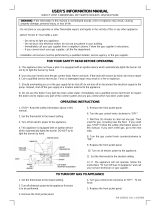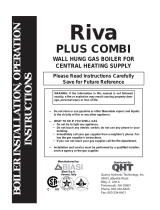
5
V - BEFORE INSTALLING THE BOILER
In the State of Massachusetts, boiler installation must
conform to state code 248 CMR which includes but is
not limited to:
This product must be installed by a licenced Plumber •
or Gastter.
When exible connectors are used, the maximum •
length shall not exceed 36 inches.
When lever type gas shut-offs are used, they shall be •
T-handle type.
For all side wall horizontally vented gas fueled equipment
installed in every dwelling, building or structure used in
whole or in part for residential purposes, including those
owned or operated by the commonwealth and where the
side wall exhaust vent termination is less than seven (7)
feet above nished grade in the area of the venting includ-
ing but not limited to, decks and porches, the following
requirements shall be satised:
Installation of carbon monoxide detectors:1.
At
the time of installation of the side wall horizontal vent-
ed gas fueled equipment, the installing plumber or
gastter shall observe that a hard wired carbon mon-
oxide detector with an alarm and battery back-up is
installed on the oor level where the gas equipment
is to be installed. In addition, the installing plumber
or gastter shall observe that a battery operated or
hard wired carbon monoxide detector with an alarm
is installed on each additional level of the dwelling,
building or structure served by the side wall horizontal
vented gas fueled equipment. It shall be the respon-
sibility of the property owner to secure the services of
qualied licensed professionals for the installation of
hard wired carbon monoxide detectors.
In the event that the side wall horizontally vented A.
gas fueled equipment is installed in a crawl space
or an attic, the hard wired carbon monoxide de-
tector with alarm and battery back-up may be in-
stalled on the next adjacent oor level.
In the event that the requirements of this subdivi-B.
sion can not be met at the time of completion of
installation, the owner shall have a period of thirty
(30) days to comply with the above requirements;
provided, however, that during said thirty (30) day
period, a battery operated carbon monoxide detec-
tor with an alarm shall be installed.
Approved carbon monoxide detectors:2.
Each
carbon monoxide detector as required in accordance
with the above provisions shall comply with NFPA 720
and be ANSI/UL 2034 listed and IAS certied.
Signage3.
: A metal or plastic identication plate shall
be permanently mounted to the exterior of the building
at a minimum height of eight (8) feet above grade di-
rectly in line with the exhaust vent terminal for the hori-
zontally vented gas fueled heating appliance or equip-
ment. The sign shall read, in print size no less than
one-half (1/2) inch in size, “GAS VENT DIRECTLY
BELOW. KEEP CLEAR OF ALL OBSTRUCTIONS”.
Inspection4.
: The state or local gas inspector of the
side wall horizontally vented gas fueled equipment
shall not approve the installation unless, upon inspec-
tion, the inspector observes carbon monoxide detec-
tors and signage installed in accordance with the pro-
visions of 248 CMR 5.08(2)(a)1 through 4.
INSTALLERS - Follow local regulations with respect
to installation of Carbon Monoxide Detectors. Fol-
low maintenance recommendations in this manual.
WARNING
!
Review the following before installing the boiler
This boiler product is a gas-red, direct vent, condensing
boiler and must be installed in accordance with all appli-
cable federal, state and local building codes including, but
not limited to the following:
United States
- Installation shall conform with National
Fuel Gas Code (NFPA-54/ANSI Z223.1- latest edition)
Canada
- Installation shall be in accordance with CSA-
B149.1 and .2 installation codes.
Where required by the authority having jurisdiction, the in-
stallation must conform to the ASME Safety Code for Con-
trols and Safety Devices for Automatically Fired Boilers,
No.CSD-1.
The installation must conform to the requirements of the au-
thority having jurisdiction or, in the absence of such require-
ments, to the National Fuel Gas Code, ANSI Z223.1 - latest
revision.





















